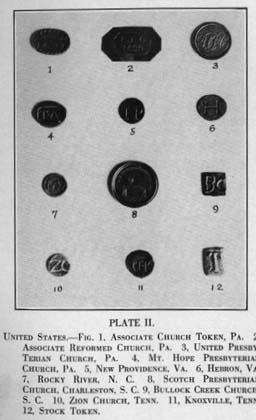

One of the distinguishing marks of Roman Catholicism is the high value it places on the Eucharist. Worship services focus on the celebration of the mass, and many parts of church law are designed to protect the sacrament from improper celebration. Most Protestants believe that their churches do not have such important boundaries around what most of them called the Lord's Supper. Such Protestants forget the place of the communion token in their past.
Tokens were commonly used in Presbyterian churches in Scotland and America, from the Reformation through the early nineteenth century. In the weeks before the celebration of communion, the church's elders would visit each member and examine his or her knowledge of the faith and purity of life. Those who met with the elders' approval were given a small lead token which permitted them to receive communion. The goal was a careful protection of the Table from profanation by immoral or unfaithful people. It was part of a larger system of church discipline.
Through the acculturation of the church and the rise of liberal theology during the nineteenth century, communion tokens fell out of favor. Theologically, clergy and elders came to see communion as a means of grace rather than a reward for good behavior. Socially, members came to see church discipline as unfashionable and "judgmental."
The Presbyterian Historical Society has a large collection of tokens from both Scotland and America at its office in Montreat, North Carolina. An assistant curator at the foundation, Mary McWhorter Tenney, wrote about the tokens in 1936, tracing their history and arguing that a restoration of tokens--and the attendant discipline--would revitalize the church. (An excerpt from Tenney's book is a document .) These tokens are part of that collection; the photograph is taken from Tenney's book.
Mary McWhorter Tenney, Communion Tokens: Their History and Use, With a Treatise on the Relation of the Sacrament to the Vitality and Revivals of the Church (Grand Rapids, Michigan: Zondervan Publishing House, 1936), 11-16.
Return to the objects page
Return to the project home page